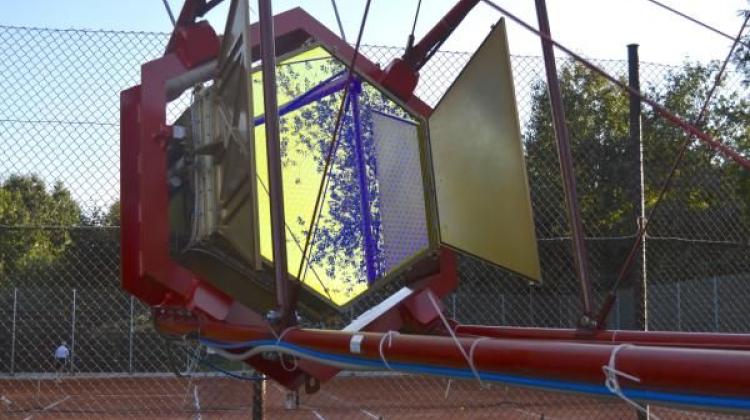Successful Polish tests of a prototype telescope

The prototype SST-1M telescope opened its silicon "eye" and recorded the first flashes of Cherenkov radiation during tests at the Institute of Nuclear Physics of the Polish Academy of Sciences in Kraków - the Polish CTA Project Consortium reported on Tuesday.
Earlier, over a dozen days, a Polish-Swiss team of engineers mounted a camera at the top of the telescope at the Institute of Nuclear Physics PAS in Kraków. Observation tests were performed on the night of August 31st.
The atmospheric conditions in Kraków turned out to be the main problem during the commissioning. Humidity varied from 30% during the day to 95% at night, which required careful monitoring of the conditions in the camera and pumping dry air to prevent the electronics from being damaged. The atmospheric conditions in which CTA telescopes will work, will be quite different. The Southern CTA Observatory will be built in the Atacama Desert in Chile - one of the driest areas in the world.
Shortly after midnight, the decision was made to open the camera cover and start testing. Commands for the telescope were issued remotely from Geneva. The selected source of gamma radiation was the quasar 1ES 1959+650, visible in in the constellation Draco. The observation was a success - flashes of Cherenkov radiation generated by gamma photons and cosmic rays were recorded. Observations took one and a half hours and over 2 million photons were recorded. 342 gigabytes of data were collected.
SST-1M (Single-mirror Small-size Telescope) telescopes are planned to be one of the parts of "small" telescopes for the CTA Observatory. The decision on using them will be made at a later point.
The SST-1M project is run by a consortium of 17 institutions from 5 countries (Poland, Switzerland, the Czech Republic, Ireland and Ukraine) and coordinated by the University of Geneva. The Institute of Nuclear Physics of the Polish Academy of Sciences in Kraków has designed and built the mechanical structure of the telescope with the drive. The camera using innovative silicon photomultipliers was developed in cooperation of scientists and engineers from three Kraków institutions: the Jagiellonian University, the AGH University of Science and Technology and the Institute of Nuclear Physics PAS.
Polish scientists have developed fully digital electronics to collect signals, while the University of Geneva has built the photovoltaic array of the camera, its mechanics and cooling system. Two other Polish institutions also took part in the construction - the Nicolaus Copernicus Astronomical Center in Warsaw and in Toruń, which developed the computer data recording system and telescope positioning system. In the case of the positioning system, the Space Research Centre PAS in Warsaw was also involved.
The CTA, or Cherenkov Telescope Array, is a planned network of telescopes for indirect gamma-ray observation. The observatory will to have a north and a south section. One will be located in the Canary Islands and the other most likely in the European Southern Observatory (ESO) in the Atacama Desert in Chile. About 1350 scientists and engineers from 32 countries are involved in the project. Poland has a significant share in the work.
The observatory will be used to study gamma radiation from astronomical objects. The Earth\'s atmosphere protects us from this radiation, but scientists have a method for its indirect observation from the surface of the Earth. When high-energy gamma photons enter the Earth\'s atmosphere, they generate the so-called Cherenkov radiation, which can be recorded in the optical range. (PAP)
PAP - Science and Scholarship in Poland
cza/ zan/ kap/
tr. RL
Przed dodaniem komentarza prosimy o zapoznanie z Regulaminem forum serwisu Nauka w Polsce.















